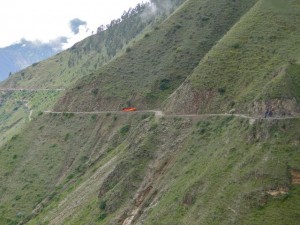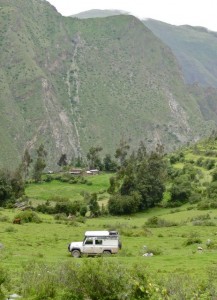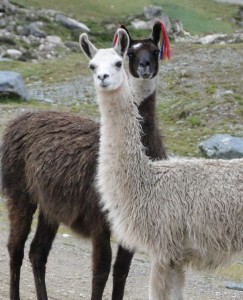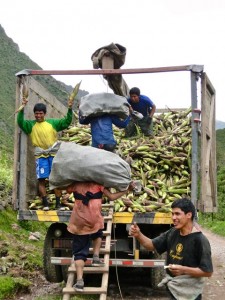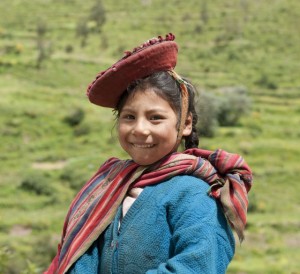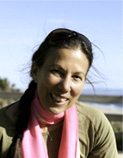Eleven days now that we’ve been driving, and while I haven’t been able to bond with any Peruvian cities, (except a tiny bit with Cusco) the countryside is getting under my skin in a way that in the beginning I couldn’t imagine. The landscapes we pass through are immense and impressive, the scenery an astonishment, so enormous and convoluted it’s as if the slopes are loathe to reveal their secrets. These days I get depressed when we return to the drab, sprawling towns and cities that are an inevitable part of our route, and can’t wait to return to the mountains.
Despite the sculpted sheerness, and vast overlapping secret valleys, every slope is densely farmed. There’s nothing I’ve seen in this world to compare with Peruvians ability to grow things in seemingly inaccessible places. Yet, traveling with Brunhilde has brought things down to an intimate scale that I don’t think would be available any other way. The dirt roads are narrow and as twisty as a snake with a stomach ache. It’s impossible to go fast, thus I have time to look into the eyes of villagers moving their pigs and sheep up the road, to glance into courtyards, to holler “Hola” to kids playing by the roadside, to smell sweet smoke from a household fire.
On many days we see fewer than a couple handfuls of vehicles on the road (outside of towns, of course). And much of our driving time is spent in the isolated countryside and hamlets that no one would ever bother to visit, because there’s nothing touristy about them. Completing hundreds of hairpin turns as we climb, we burst out on the expansive green rolling hills of the altiplano, dotted with tarns, swooped over by an occasional eagle. It’s vast and empty, yet vivid with signs of Inca (or other civilizations) farming from centuries ago… parallel contour lines carved into the land, to hold water as a form of thermoregulation to prevent crops from freezing at night. The level altiplano roads are in fine condition, a pale grey ribbon through the high plains, linking one hilltop or pass to the next for miles on end. Intermittently, thatched shepherd huts appear, with the corresponding herd of muddy, tousled sheep or white alpacas surveyed by one or two young girls in woven pink and red skirts, candy-colored striped shawls wrapped around their shoulders.
Then we plunge down again, more hairpin turns, occasionally meeting a combi-van packed with 20 people, passengers between villages; one such van had 3 sheep tied on its roof. I try to keep my eyes focused ahead, but have looked over the edge enough to know that if the road gave way under us (as we’ve seen evidence of in plenty of places) it’d be like one of those recurring nightmares I had when I was a kid, in which I found myself flying uncontrollably, knowing that I was in for a hard landing. Then, though, I’d land with a whomp on my bed and wake up unhappy. Here, if we tipped over, I’d be dead.
As we return to lower altitudes, we drive through towering eucalyptus groves, a non-native tree transplanted here by some creative New Zealanders. It’s a preservationist’s nightmare, taking over from the native trees in unprecedented numbers. But, it’s great for villagers needing roof beams and fire wood (the native tree is short and rather gnarled). All I have to do to calm my nerves after a hair-raising descent is close my eyes and breathe in the moist, eucalyptus-scented air. It’s like a drive-through spa. When I open my eyes again, I see luscious, brilliant dahlias dripping over brown mudbrick walls. Prickly pears bloom and water cascades down the cliffs. We sometimes navigate through rockfalls–we squeezed through one with little more than 3 inches clearance–. And yes, I do of course think that similar rocks could crash onto our car at any moment. The sad thing would be it’d squash our tent, which we haven’t even used yet.

The raging Urubamba, which undercut the railroad on the bank and closed Machu Picchu for four months
Bernard has hijacked my GPS. I don’t know whether to be offended or relieved by this. The unit is permanently installed next to the steering wheel, where only he can see it. The other day as we drove along the frantic, raging Rio Mantara, I mentioned to Bernard my surprise that the river was going in the opposite direction from us. “You know,” I said. “I always expect that if I’m driving along a river, it’ll be moving in the same direction as me.” I followed that statement with another, even more memorable one, revealing that, as far as I’m concerned, whatever direction I’m facing is north. There was no need for Bernard to panic over this. I could tell by the way he lovingly stroked the GPS which was well out of my grasp, that he was confident I couldn’t cause any trouble.
In our first five days of driving, the GPS recorded that we climbed 105,000 feet! And of course everything we climb, we then have to drive down. Brunhilde is the perfect vehicle here, especially with the chilled champagne in her fridge and the Toblerone bar that could double as a car jack, both unexpected gifts from our car outfitter in the UK. With many hours of yanking the steering wheel back and forth, Bernard’s looking like Popeye after downing one of those cans of spinach…. his arms are starting to bulge in near-miraculous ways.
Speaking of spinach, I know there’s a guinea pig (cuy) in my future, but so far, I’ve been avoiding it. Cuy appears in many forms on all menus. I’m not squeamish, but somehow eating a cuy would be like eating my pet hamster. Chicken, however, is ubiquitous. At first, I was thrilled about this, but after chicken every night, I’ve about had it with poultry. As for potatoes, I know there are great ones here, but I haven’t encountered any on my plate yet.
Today in a remote hamlet up a narrow valley from Ollantaytambo, I talked myself into trying chicha, the local fermented beverage made from corn. I approached the young man guarding a tin pot covered with a dirty green cloth, where he sat on a damp clump of grass by the muddy road.. “Es chicha?” I asked, stating the obvious, since I could see the liquid in his own glass. I asked for just a smidge, and offered him half my Clif bar in exchange. He ladled out a beige, nearly opaque, frothy liquid from the bottom of the pot, and I immediately had inklings that this could end up like the night I drank a mugful of yak butter tea in a dark hut in the Himalayas. Not good. But, I stood there and sipped anyway. Bernard, as usual when there’s something uncertain to try, pretended he didn’t know me. I can tell you that chicha, regardless of what bacteria this batch might foster, was actually a reasonable, though rather sour, drink. The youth told me happily that the Clif bar was “Muy rica” which means he thought it pretty tasty. I said the same thing about the chicha, but had to return the glass nearly untouched. I noticed as we got back in the car, that he held the Clif bar, also nearly untouched, in his fingers. So much for cross-cultural food exchanges.
Two days ago, we were stopped by a highway road block in the Apurimac Canyon for 3 hours. This fine stretch of pavement–part of the main highway between Lima and Cusco– had been inexorably chewed up and spit out by the brick-red barrage of the Rio Apurimac. Rather than let traffic pass one direction at a time, the highway authorities closed the road altogether. So we sat, read and got bitten by black flies till the road reopened promptly at 5pm. At that point, the authorities skedaddled and let two directions of traffic duke it out on their own. Thus, we arrived at the one point in the 14km-long repair zone where the road narrowed to one lane, to find an endless line of transport trucks and buses facing us. They got there a minute before we did and were already roaring across the one-lane hump of gravel and boulders. They followed each other like elephants trunk to tail.
There was no way to wedge ourselves in and get across between one truck and the next. Another hour’s wait was in store for us if we waited passively while all the trucks passed. “THis just isn’t fair,” I told Bernard. “I’m going to fix it.” I jumped out of the car and stumbled across the boulders, barely one foot from the rumbling 18-wheelers. Reaching the other side, where the road widened, I planted myself in front of the next truck that was ready to cross. I yelled some stern words at the driver, such as “It’s our turn now,” crossed my arms and prayed fervently that Bernard would hurry across when the opening arrived. The driver whom I was blocking stuck his head out the window, flailing his arms and shouting. Other trucks and buses took up the hue and cry, horns honking and blaring. But I’m used to that, because I’ve driven through India…. I studied the scenery and convinced myself that no one would run over a lady standing in the middle of the street when clearly there was another option…keeping your foot on the brake. It seemed like forever, but soon I saw Brunhilde charging across the gravel expanse to my rescue. Never did Bernard look more like a knight in shining armor.
And one final note: I have discovered my mathematical error in the last email. 4380 meters is more like 14,370 feet, not 17,000. OK, it’s not the Death Zone, but for me, if I’m trying to sleep, it’s still the I Have A Headache Zone.
-Dina









